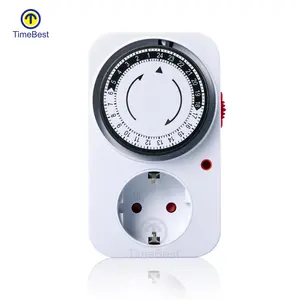(2201 products available)



























































































































































































A light timer is a device that is used to automatically control the timing of lights or electrical devices. It allows users to program specific on and off times for their lights, lamps, or other appliances, providing convenience, security, and energy savings. Light timers are commonly used in homes, offices, and outdoor settings to schedule lighting according to personal preferences or needs.
First, digital light timers feature electronic displays and buttons for programming precise schedules for lighting. They offer more advanced options, such as daily or weekly programs, countdown timers, and random settings for added security. Digital timers provide flexibility in setting multiple on or off times and are suitable for various lighting needs. Second, in-wall light timers are installed directly into the wall switch or electrical box, replacing the existing light switch. They offer a seamless and integrated solution for automating lighting control in a room or area. In-wall timers can be programmed to operate multiple lights simultaneously or independently, enhancing convenience and customization options. In addition, smart light timers connect to a Wi-Fi network and can be controlled remotely using a smartphone or voice commands through a compatible smart home system. They offer advanced features such as customizable schedules, vacation mode, and integration with other smart devices. Smart timers provide users with enhanced automation capabilities and the flexibility to manage their lighting from anywhere.
First, light timers are commonly used to enhance home security by creating the illusion of occupancy when residents are away. By programming light timers to turn on and off at specific times, homeowners can simulate the presence of someone inside the house, deterring potential intruders. It helps to protect the property and provide peace of mind to residents, especially during vacations or extended periods of absence. In addition, outdoor light timers are beneficial for managing outdoor lighting, such as landscape lights, security lights, or holiday decorations. By using outdoor timers, users can program the timing of outdoor lights to coincide with sunset and sunrise or specific events. It ensures that outdoor areas are well-lit for safety, aesthetics, or special occasions without the need for manual operation or constant monitoring.
First, don't use indoor-only timers outdoors. Make sure the exterior timers are rated for outdoor use and plug them into outdoor-rated GFCI (ground fault circuit interrupter) outlets. Second, many timers have a switch that lets people bypass the timed function. If people activate the bypass switch, the timer simply acts as a power outlet, and they will need to turn the lights on and off manually at the fixture. Third, some digital timers have a battery backup that maintains the current time as well as the on and off settings in the event of a power outage. In addition, if people are resetting a digital timer to a new time, they may need to clear the device memory before entering new settings. If people are resetting a mechanical timer, they will need to reset the tabs first.